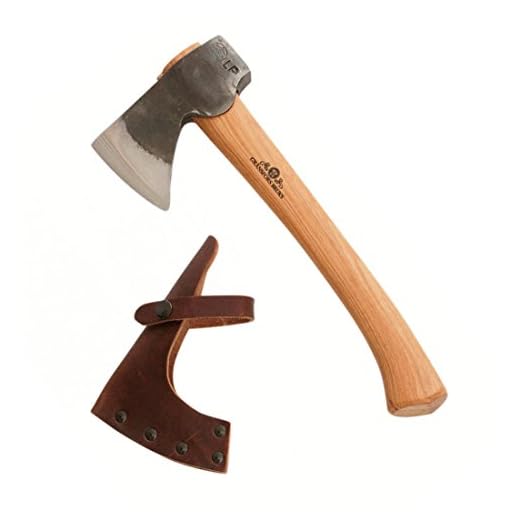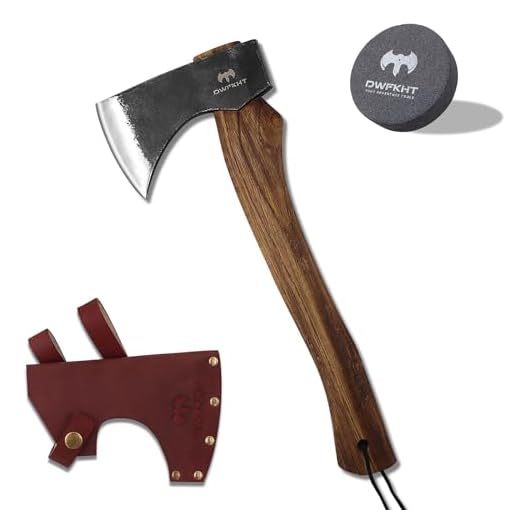

Transporting an axe as part of your checked items is permitted under specific conditions set by most airlines. Ensure that the axe is securely packed to prevent damage and injury during handling.
Always check the individual airline’s policy regarding sharp objects and tools before your trip. Some companies may have additional restrictions or requirements that need to be followed. Proper packaging often includes a sturdy case that can withstand the rigors of checked travel.
Security regulations at airport checkpoints typically classify axes as prohibited items in carry-on bags. However, placing them in checked bags is generally acceptable if they adhere to safety guidelines. Moreover, informing the airline during check-in can facilitate a smoother process.
Lastly, consider any legal restrictions at your destination regarding the transport of such items. Local laws may differ significantly, affecting whether it is permissible to bring an axe into certain areas or countries. Always conduct thorough research prior to your travels to avoid complications.
Transporting an Axe in Checked Baggage
It is permissible to include a hatchet or similar tool within the hold baggage for air travel. However, certain stipulations must be observed.
- Ensure that the item is securely packaged to prevent injury to baggage handlers or damage to other items.
- Verify the specific airline regulations, as the policies may vary between carriers.
- Consider local laws regarding the transport of such tools to the destination, as restrictions may exist.
Prior to traveling, it’s advisable to contact the airline directly for confirmation of their policy regarding tools. In some cases, additional fees may apply for oversized or atypical items.
For safety during transit, utilize a sturdy protective case or sheath to cover the sharp edge. This measure helps avoid accidents and complies with safety practices.
Plan ahead, and allow extra time at check-in, as security may require additional scrutiny for items considered potentially hazardous.
Understanding Airline Regulations on Sharp Objects
Transporting sharp tools through airline security requires adherence to specific guidelines. Always confirm with your airline’s policy, as each may have distinct stipulations regarding sharp items.
Typically, large cutting instruments are prohibited in cabin baggage but may be allowed in cargo compartments if properly packed. Ensure that edges are securely covered to reduce risk during handling. Use original packaging or sturdy cases to prevent movement and damage.
In regards to various items, like knives, scissors, and similar tools, limitations are usually stricter. Familiarize yourself with size restrictions and other relevant details outlined by the Transportation Security Administration (TSA) or equivalent authority in your country.
Recommendations for Packing Sharp Tools
When preparing to transport your sharp implements, follow these guidelines:
- Use padded cases to inhibit movement.
- Label your package clearly to avoid confusion.
- Consult the specific rules of your travel destination, as laws may differ.
For those interested in crafting additional tools for kitchen use, explore how to make korean dish scrubber for unique ideas that require careful handling.
Conclusion
Ensuring compliance with airline regulations regarding sharp items enhances safety for all passengers. Stay informed and prepared to facilitate smoother travel experiences.
Types of Axes Permitted in Checked Luggage
Tools resembling axes may be allowed, but specific types are subject to airline policies. Always confirm with the respective carrier before packing. Typically, small hand axes and hatchets are preferable, as they are less likely to raise security concerns. Ensure that blades are not exceeding a certain length – often around 7 inches – to comply with standard regulations.
Types Allowed
1. Hatchets: These tools are generally compact and can be transported. Make sure the blade is secured within its sheath.
2. Camp Axes: Look for models that are specifically designed for camping and outdoor activities, which are usually permitted due to their size.
3. Decorative Axes: If your item has a historical or artistic significance without sharp edges, confirm with the airline as these may be allowed.
Packaging Recommendations
Wrap the tool securely to prevent any movement during transit. Consider using hard-sided bags or cases for protection. For optimal travel experience, explore options like best luggage without zippers to enhance safety. Also, look for best luggage deals black fridahy to find suitable storage solutions.
How to Properly Pack an Axe for Air Travel
Wrap the head of the tool securely using thick padding material such as bubble wrap or foam. This ensures the sharp edge and the overall integrity are preserved during handling.
Utilize a sturdy container or hard-shell case for added protection. Ensure the case is properly sized, allowing no excessive movement within. Reinforce any gaps to prevent shifting during transit.
Labeling and Documentation
Clearly label the exterior of the case indicating the contents. Include contact information to aid in the identification of the case if lost. Additionally, keep a copy of relevant regulations handy to address any inquiries from security personnel.
Weight Limits and Additional Fees
Check the weight regulations of the airline prior to packing to avoid extra fees. Weigh the container with its contents before arrival at the airport. Prepare to remove any non-compliant items if necessary to meet airline standards.
| Item | Recommended Packing Method |
|---|---|
| Head of the Tool | Wrap in Bubble Wrap |
| Handle | Secure in Sturdy Case |
| Container | Hard-shell Case with Padding |
| Labeling | Include Contact Information |
Consequences of Not Declaring an Axe in Luggage
Failing to declare a bladed tool during air travel can lead to significant repercussions. Most airlines impose strict penalties for nondisclosure, which may include fines, confiscation of the item, or even being banned from future flights with that carrier.
Security personnel might escalate the situation to law enforcement if they consider the item a threat, resulting in possible legal actions against the traveler. Being uncooperative during security inspections may further aggravate the scenario, leading to additional scrutiny or a permanent record.
Beyond immediate legal consequences, the traveler may incur extra fees for delayed flights or the need for alternative transportation arrangements if they are held for questioning. Additionally, missing connections can disrupt plans and create further financial burden.
To avoid these outcomes, always inform airline staff about any sharp tools packed for compliance with safety regulations. Transparency not only eases travel but also enhances safety for all passengers.
Alternatives to Bringing an Axe on a Flight
Consider using a multi-tool or a folding saw as practical substitutes. These items often comply with airline policies and can easily perform similar tasks without the complications of transporting a full-sized chopping tool.
Portable Tools
Small, lightweight portable tools like mini hatchets or compact camp knives are excellent choices. These instruments are manageable and can efficiently handle many outdoor tasks, including wood cutting or carving.
Rental Services
Check for local rental services at your destination. Many outdoor shops or camping facilities offer rentals for axes and other equipment, making it convenient to access tools without the hassle of travel restrictions.
Tips for Traveling with Outdoor Equipment
Prioritize knowing the specific regulations of the airline regarding large outdoor gear. Check their website or contact customer service for clarity on size, weight, and any fees associated with traveling with such items.
Utilize hard-shell cases for fragile equipment to provide added protection during transit. Ensure that items are completely secured to avoid shifting during handling.
Consider disassembling items if possible to minimize space and reduce the risk of damage. For instance, removing handles or breaking down larger pieces can help within the baggage limits.
- Label all gear clearly, including contact information, to prevent loss.
- Include a detailed packing list inside the bag for reference.
- Use padding materials such as foam or bubble wrap to safeguard sensitive areas.
Arrive early at the airport. Dealing with oversized bags may require extra time for check-in and security protocols.
Maintain all purchase and ownership documents handy in case of inquiries by airline staff regarding the equipment.
Look into renting equipment at your destination as a practical alternative. This can reduce the hassle of transporting bulky items and potential fees.
Research local regulations for outdoor gear in your travel destination, especially if your plans involve specific recreational activities.
FAQ:
Can I take an axe in my checked luggage when flying?
No, you generally cannot take an axe in your checked luggage. Most airlines and airport security regulations prohibit sharp objects, such as axes, for safety reasons. It’s important to check the specific rules of the airline you are flying with, as well as the regulations of the airport where you will be departing from.
What happens if I accidentally pack an axe in my checked luggage?
If you accidentally pack an axe in your checked luggage, it may be discovered during the security screening process. Security personnel will likely remove the item from your luggage and may dispose of it or return it to you if you can retrieve it before your flight. It’s advisable to contact your airline beforehand if you’re unsure about what’s allowed.
Are there any specific types of axes that might be allowed in checked luggage?
Typically, no type of axe is allowed in checked luggage due to safety and security regulations. This includes camping axes, hatchets, and any other variations. If you need to transport an axe for activities such as camping or outdoor work, consider shipping it separately through a courier service or checking with your airline about their specific policies on tools.
How can I transport tools like an axe safely if I cannot take it in my luggage?
If you need to transport an axe or similar tools, consider using a specialized shipping service or checking with your airline about shipping it as cargo. Alternatively, you can buy or rent equipment at your destination to avoid transport issues. Always ensure that whatever method you choose complies with local laws and regulations.
Are there exceptions for carrying axes in checked luggage depending on the airline?
Some airlines may have different policies regarding the transportation of tools and sharp objects. While most follow standard aviation security guidelines that prohibit items like axes, it’s wise to verify directly with your airline. If an exception exists, the airline will provide specific instructions on how to pack and declare the item.








